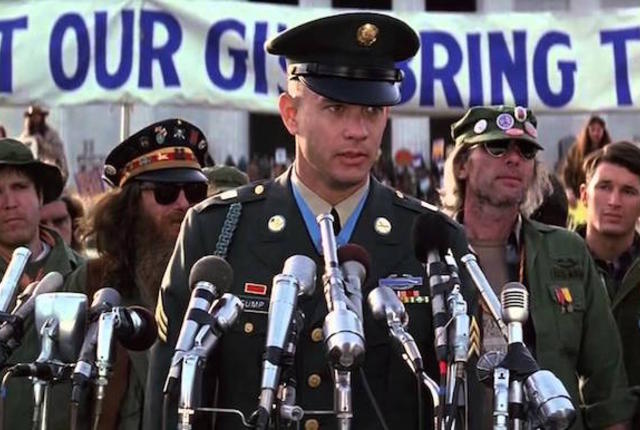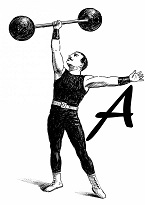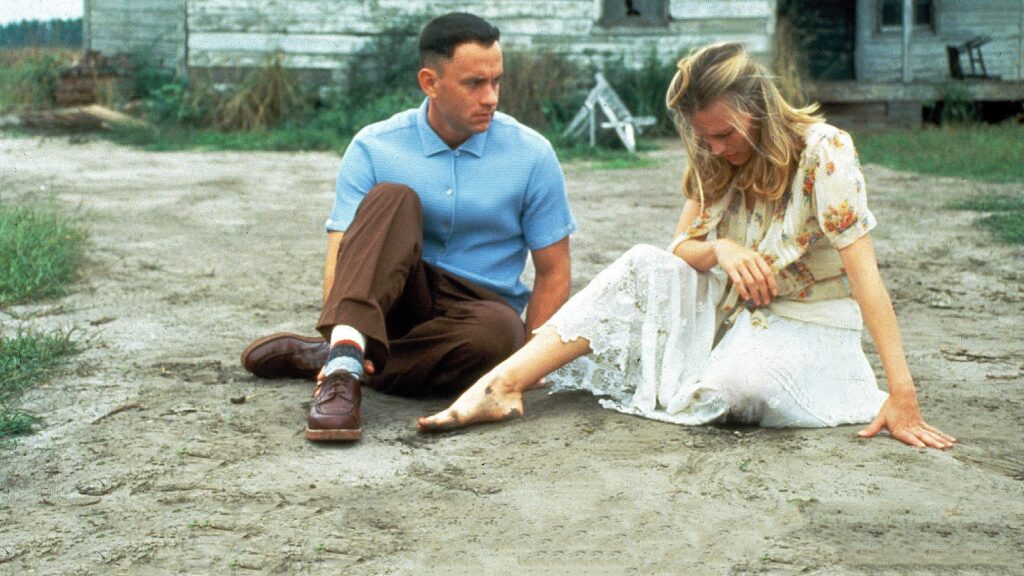Robert Zemeckis’s “Forrest Gump” (1994) tells the story of Forrest Gump, a dim-witted yet caring man who unintentionally experiences some of the most important events of the 20th Century in the United States. Gump, who is portrayed by Tom Hanks, travels the world as he works in different odd jobs, including fighting in Vietnam with his best-friend Bubba and superior officer Lieutenant Dan (played by Gary Sinise), playing professional ping pong, and owning a shrimping business. Throughout the film, Gump constantly meets up with his childhood friend and love interest, Jenny Curran, played by Robin Wright. In his quest to finally end up with Jenny, Forrest does everything in his power to be with her, all while having to live with the fact that he is mentally deficient, a disadvantage which he finally accepts.
The cinematography in “Forrest Gump” is wonderful, as Zemeckis uses many sweeping shots throughout many scenes. Zemeckis particularly uses the zoom shot, intensifying scenes where characters are reading long and deep monologues. One aspect of this film which is incredible for its time is the special effects. The film was praised by audiences on its use of integrating real clips from the late 1960s and early 1970s with scenes in the movie. The use of CGI in some scenes is unbelievable, as there was nothing like it during the ‘90s. An example of this is the scene where Forrest Gump is invited to the White House as a member of the All-American football team, where Hanks character is shown to be shaking hands with then president John F. Kennedy. It’s interesting to note that this special affect was done by using archival footage mixed with Hanks walking along a blue screen. Because of this, you can tell that “Forrest Gump” was a passion project for Zemeckis. As an audience member and a critic, it is easy to see that Zemeckis cared about this film; and that I can appreciate.
While most of the filming took place in South and North Carolina and Virginia, the film was set in multiple places, including Alabama, Washington D.C, and Vietnam. I enjoyed how the story allowed for multiple destinations, as Forrest frequently traveled and “went where the wind blew him.” The scenes in Vietnam felt genuine, almost documentary like (except for Forrest running into an airstrike five times). The special effects coincided very well with the settings: everything appeared very real and alive.
While many critics felt that the story was a bit childish, I happened to enjoy it. The film begins with the story of Forrest as a child, who is frequently bullied because of his appearance and physical disabilities. As a young boy, Forrest wore leg brace to help his curved spine, a feat which he was often teased about. On one day, he happened to be walking home from school with his best friend Jenny when a group of boys started to chase him in a truck. As he was running away from the bullies, his leg braces snapped off and unknowingly to everyone around him, Forrest was a very fast runner. This is where the audience sees Forrest’s life takes off. The rest of the film follows Forrest’s life as he experiences some of the most important events of the 1960s and 1970s. I enjoyed the integration of the Forrest Gump character into some of the major events in US history. The story arc is wonderful, as we learn so much about the character while he is narrating in real-time while waiting for a bus in Savannah, Georgia. One thing to note is that while you’re watching this film, don’t take it too seriously. Many watch this film expecting it to be hyper-realistic, while in reality, the film is more character-driven. Knowing this, you will enjoy watching “Forrest Gump” much more.

The dialogue in this film is wonderful, giving special praise to Tom Hanks’s “deep-southern” accent. In an interview with Graham Norton, Hanks tells the audience that he came up with his signature voice by listening and talking to the then young Michael Conner Humphreys, who played young Forrest. The conversations between Forrest and Jenny and Forrest and Lieutenant Dan were always heartfelt and meaningful. During the scenes with Forrest and Jenny, there was a real chemistry between the two, and it really felt that the pair loved each other. The relationship between Dan and Forrest consistently grew as the film went on, with duo helping each other at different points in their lives. Eric Roth’s screenplay was well thought of, and allowed for Hanks, Wright, and Sinise to shine in their roles. Roth did a wonderful job, and his story supported the character development of Forrest, Dan, and Jenny.
Where “Forrest Gump” shines the most is its character development. At the beginning of the film, Forrest is just a little boy who was unable to fake any friends on the account of his disability. But by the end, Forrest has made a name for himself in the world and has some of the closest friends one could ask for. From growing up as a helpless child to becoming a war hero and successful shrimp salesman, Forrest’s development in this film in nothing short of spectacular.
The way Zemeckis portrays Forrest’s life is wonderful, as he travels the world on a flexible schedule, learning and growing as a human being along the way. Along with Forrest, Jenny is another dynamic character in the film, as her arc spirals out of control half way through the film. Growing up with an abusive father, Jenny always looks towards Forrest for help. Whether it was attending the “March on the Pentagon” or struggling with a heroin addiction, Jenny almost always found herself being saved by Forrest. The two had an inseparable bond that managed to last their lifetimes. But, when Jenny wasn’t there, Forrest had to look towards another friend: Lieutenant Dan Taylor, Forrest’s CO while he was in Vietnam.
During his lifetime, we see Taylor change a lot. As a soldier, Taylor’s fate was left in God’s hands; or so he thought. Like his relatives before him, Taylor was destined to die as a hero on the battlefield in Vietnam. After his platoon was ambushed, Taylor laid injured as he watched his men die out on the battlefield. After Forrest escaped the ambush, he ran back into the action multiple times in search of his friend Bubba, a fellow soldier. Saving many of the men in the platoon, Forrest saw Taylor on the ground with his legs torn off. As Forrest ran back in for the last time to find Bubba dead, he heard Taylor’s voice from the distance. Laying there with his legs torn off, Forrest saved an angry Taylor, as he wanted to be left alone and die as a hero. Initially, Taylor blamed Forrest for his status as a cripple. But, the two became close and eventually became best friends and business partners. Zemeckis did an amazing job of creating three characters that had no relation towards each other originally. But by the end of the film, Forrest would go on to be with the woman he loves and have his best friend right there by his side.

The soundtrack in “Forrest Gump” is great, especially if you’re a fan of the music during the counterculture era. Featuring some of the most famous artists of that time, the film does a great job of including songs that have meaning and further augment the scene. Whether it’s the sound of helicopters flying over Vietnam while “Fortunate Son” by Creedence Clearwater Revival is blaring, or Jenny listening to the solo of “Free Bird” by Lynyrd Skynyrd while contemplating on taking her own, “Forrest Gump” does a great job of integrating its music in with each shot.
Arthur Schmidt, the editor of this film, did a superb job. Like I said previously, the special effects in this film were outstanding for its time, and Schmidt is one of the reasons behind that. Without him, I don’t think this movie would have done half as well, as the film relied on making the audience believe that Forrest Gump was a real human being.
Never would I have thought that the story of a mentally-deficient man living with a go-with-the-flow lifestyle would make for an interesting film. The “Back To The Future” director did not fall short on this one, as I believe this is Zemeckis’s greatest film of his career. I give him special praise on his interesting plot and character development. Along with Eric Roth and Arthur Schmidt, the crew behind “Forrest Gump” couldn’t have made this film any better. The performances by Hanks, Wright, and Sinise were all outstanding. “Forrest Gump” is an enjoyable movie that explores the ideas of love and agony while following the life of a simple man who wants to experience the world.


